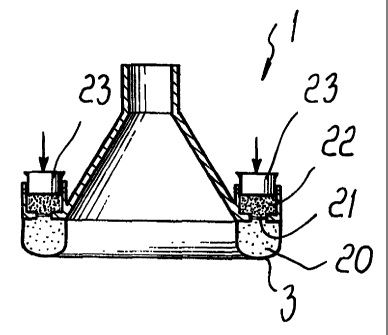Une partie des informations de ce site Web a été fournie par des sources externes. Le gouvernement du Canada n'assume aucune responsabilité concernant la précision, l'actualité ou la fiabilité des informations fournies par les sources externes. Les utilisateurs qui désirent employer cette information devraient consulter directement la source des informations. Le contenu fourni par les sources externes n'est pas assujetti aux exigences sur les langues officielles, la protection des renseignements personnels et l'accessibilité.
L'apparition de différences dans le texte et l'image des Revendications et de l'Abrégé dépend du moment auquel le document est publié. Les textes des Revendications et de l'Abrégé sont affichés :
| (12) Brevet: | (11) CA 2329251 |
|---|---|
| (54) Titre français: | MASQUE FACIAL OU NASAL SOUPLE POUR VENTILATION NON INVASIVE DES PATIENTS EN GENERAL |
| (54) Titre anglais: | CUSTOMIZABLE FACE OR NOSE MASK FOR THE NONINVASIVE VENTILATION OF PATIENTS IN GENERAL |
| Statut: | Réputé périmé |
| (51) Classification internationale des brevets (CIB): |
|
|---|---|
| (72) Inventeurs : |
|
| (73) Titulaires : |
|
| (71) Demandeurs : |
|
| (74) Agent: | OSLER, HOSKIN & HARCOURT LLP |
| (74) Co-agent: | |
| (45) Délivré: | 2009-04-07 |
| (86) Date de dépôt PCT: | 1999-05-11 |
| (87) Mise à la disponibilité du public: | 1999-11-18 |
| Requête d'examen: | 2004-05-11 |
| Licence disponible: | S.O. |
| (25) Langue des documents déposés: | Anglais |
| Traité de coopération en matière de brevets (PCT): | Oui |
|---|---|
| (86) Numéro de la demande PCT: | PCT/US1999/010300 |
| (87) Numéro de publication internationale PCT: | WO1999/058198 |
| (85) Entrée nationale: | 2000-10-19 |
| (30) Données de priorité de la demande: | ||||||
|---|---|---|---|---|---|---|
|
La présente invention concerne un masque facial ou nasal souple (1) pour la ventilation non invasive de patients en général, qui comprend un corps de masque (2) formant au moins une coiffe qui vient s'adapter sur le visage du patient. Le masque selon l'invention offre la particularité de comprendre, au moins dans sa partie coiffe, une chambre (3) renfermant au moins un produit sans mémoire de forme qui, lorsqu'il est activé, produit une substance chimique et/ou une réaction physique entraînant la transformation de ce produit sans mémoire de forme en un produit à mémoire de forme qui épouse spontanément le modelé du visage.
A customized face
or nose mask (1) for the
non-invasive ventilation of
patients in general, which
comprises a mask body
(2) forming at least one
surface portion which can
be coupled to the face of
the patient. The peculiarity
of the invention consists
in that it comprises, at least
at the surface portion, a
chamber (3) for containing
at least one product
without shape memory
which can be activated to
produce a chemical, and/or
physical reaction for the
transformation of the at
least one product without
shape memory into a product
having shape memory which
spontaneously models itself on the patient's face.
Note : Les revendications sont présentées dans la langue officielle dans laquelle elles ont été soumises.
Note : Les descriptions sont présentées dans la langue officielle dans laquelle elles ont été soumises.

Pour une meilleure compréhension de l'état de la demande ou brevet qui figure sur cette page, la rubrique Mise en garde , et les descriptions de Brevet , États administratifs , Taxes périodiques et Historique des paiements devraient être consultées.
| Titre | Date |
|---|---|
| Date de délivrance prévu | 2009-04-07 |
| (86) Date de dépôt PCT | 1999-05-11 |
| (87) Date de publication PCT | 1999-11-18 |
| (85) Entrée nationale | 2000-10-19 |
| Requête d'examen | 2004-05-11 |
| (45) Délivré | 2009-04-07 |
| Réputé périmé | 2010-05-11 |
Il n'y a pas d'historique d'abandonnement
| Type de taxes | Anniversaire | Échéance | Montant payé | Date payée |
|---|---|---|---|---|
| Le dépôt d'une demande de brevet | 300,00 $ | 2000-10-19 | ||
| Enregistrement de documents | 100,00 $ | 2001-03-30 | ||
| Enregistrement de documents | 100,00 $ | 2001-03-30 | ||
| Taxe de maintien en état - Demande - nouvelle loi | 2 | 2001-05-11 | 100,00 $ | 2001-05-11 |
| Taxe de maintien en état - Demande - nouvelle loi | 3 | 2002-05-13 | 100,00 $ | 2002-04-29 |
| Taxe de maintien en état - Demande - nouvelle loi | 4 | 2003-05-12 | 100,00 $ | 2003-04-30 |
| Taxe de maintien en état - Demande - nouvelle loi | 5 | 2004-05-11 | 200,00 $ | 2004-04-29 |
| Requête d'examen | 800,00 $ | 2004-05-11 | ||
| Taxe de maintien en état - Demande - nouvelle loi | 6 | 2005-05-11 | 200,00 $ | 2005-05-02 |
| Taxe de maintien en état - Demande - nouvelle loi | 7 | 2006-05-11 | 200,00 $ | 2006-04-26 |
| Taxe de maintien en état - Demande - nouvelle loi | 8 | 2007-05-11 | 200,00 $ | 2007-04-24 |
| Taxe de maintien en état - Demande - nouvelle loi | 9 | 2008-05-12 | 200,00 $ | 2008-04-28 |
| Taxe finale | 300,00 $ | 2009-01-16 |
Les titulaires actuels et antérieures au dossier sont affichés en ordre alphabétique.
| Titulaires actuels au dossier |
|---|
| MALLINCKRODT INC. |
| Titulaires antérieures au dossier |
|---|
| BERGAMASCHI, PAOLO |
| FINI, MASSIMO |
| MALLINCKRODT HOLDINGS B.V. |